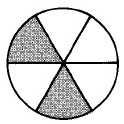4.8: Suplemento de ejercicio
- Page ID
- 116719
Fracciones de números enteros
Para Problemas 1 y 2, nombra la fracción sugerida.
Ejercicio\(\PageIndex{1}\)

- Contestar
-
\(\dfrac{2}{6}\)o\(\dfrac{1}{3}\)
Ejercicio\(\PageIndex{2}\)

Para los problemas 3-5, especifique el numerador y el denominador.
Ejercicio\(\PageIndex{3}\)
\(\dfrac{4}{5}\)
- Contestar
-
numerador, 4; denominador, 5
Ejercicio\(\PageIndex{4}\)
\(\dfrac{5}{12}\)
Ejercicio\(\PageIndex{5}\)
\(\dfrac{1}{3}\)
- Contestar
-
numerador, 1; denominador, 3
Para problemas 6-10, escriba cada fracción usando dígitos.
Ejercicio\(\PageIndex{6}\)
Tres quintas partes
Ejercicio\(\PageIndex{7}\)
Ocho once
- Contestar
-
\(\dfrac{8}{11}\)
Ejercicio\(\PageIndex{8}\)
Sesenta y uno cuarenta primeros
Ejercicio\(\PageIndex{9}\)
Doscientos seis milésimas
- Contestar
-
\(\dfrac{200}{6,000}\)
Ejercicio\(\PageIndex{10}\)
cero décimas
Para los problemas 11-15, escribe cada fracción usando palabras.
Ejercicio\(\PageIndex{11}\)
\(\dfrac{10}{17}\)
- Contestar
-
diez diecisiete
Ejercicio\(\PageIndex{12}\)
\(\dfrac{21}{38}\)
Ejercicio\(\PageIndex{13}\)
\(\dfrac{606}{1431}\)
- Contestar
-
seiscientos seis, mil cuatrocientos treinta y primeros
Ejercicio\(\PageIndex{14}\)
\(\dfrac{0}{8}\)
Ejercicio\(\PageIndex{15}\)
\(\dfrac{1}{16}\)
- Contestar
-
decimosexto
Para los problemas 16-18, indica cada numerador y denominador y escribe cada fracción usando dígitos.
Ejercicio\(\PageIndex{16}\)
Un minuto es sesenta de hora.
Ejercicio\(\PageIndex{17}\)
En una caja que contiene cuarenta y cinco componentes electrónicos, se sabe que ocho son defectuosos. Si se eligen tres componentes al azar de la caja, la probabilidad de que los tres sean defectuosos es de cincuenta y seis catorce mil ciento noventa.
- Contestar
-
numerador, 56; denominador, 14,190
Ejercicio\(\PageIndex{18}\)
Alrededor de tres quintas partes de los alumnos de una clase de álgebra universitaria recibieron una “B” en el curso.
Para los problemas 19 y 20, sombrear la región correspondiente a la fracción dada.
Ejercicio\(\PageIndex{19}\)
\(\dfrac{1}{4}\)

- Contestar
-

Ejercicio\(\PageIndex{20}\)
\(\dfrac{3}{7}\)

Fracción apropiada, fracción impropia y números mixtos
Para problemas 21-29, convierta cada fracción impropia a un número mixto.
Ejercicio\(\PageIndex{21}\)
\(\dfrac{11}{4}\)
- Contestar
-
\(2 \dfrac{3}{4}\)
Ejercicio\(\PageIndex{22}\)
\(\dfrac{15}{2}\)
Ejercicio\(\PageIndex{23}\)
\(\dfrac{51}{8}\)
- Contestar
-
\(6 \dfrac{3}{8}\)
Ejercicio\(\PageIndex{24}\)
\(\dfrac{121}{15}\)
Ejercicio\(\PageIndex{25}\)
\(\dfrac{356}{3}\)
- Contestar
-
\(118 \dfrac{2}{3}\)
Ejercicio\(\PageIndex{26}\)
\(\dfrac{3}{2}\)
Ejercicio\(\PageIndex{27}\)
\(\dfrac{5}{4}\)
- Contestar
-
\(1 \dfrac{1}{4}\)
Ejercicio\(\PageIndex{28}\)
\(\dfrac{20}{5}\)
Ejercicio\(\PageIndex{29}\)
\(\dfrac{9}{3}\)
- Contestar
-
3
Para problemas 30-40, convierta cada número mixto a una fracción impropia.
Ejercicio\(\PageIndex{30}\)
\(5 \dfrac{2}{3}\)
Ejercicio\(\PageIndex{31}\)
\(16 \dfrac{1}{8}\)
- Contestar
-
\(\dfrac{129}{8}\)
Ejercicio\(\PageIndex{32}\)
\(18 \dfrac{1}{3}\)
Ejercicio\(\PageIndex{33}\)
\(3 \dfrac{1}{5}\)
- Contestar
-
\(\dfrac{16}{5}\)
Ejercicio\(\PageIndex{34}\)
\(2 \dfrac{9}{16}\)
Ejercicio\(\PageIndex{35}\)
\(17 \dfrac{20}{21}\)
- Contestar
-
\(\dfrac{377}{21}\)
Ejercicio\(\PageIndex{36}\)
\(1 \dfrac{7}{8}\)
Ejercicio\(\PageIndex{37}\)
\(1 \dfrac{1}{2}\)
- Contestar
-
\(\dfrac{3}{2}\)
Ejercicio\(\PageIndex{38}\)
\(2 \dfrac{1}{2}\)
Ejercicio\(\PageIndex{39}\)
\(8 \dfrac{6}{7}\)
- Contestar
-
\(\dfrac{62}{7}\)
Ejercicio\(\PageIndex{40}\)
\(2 \dfrac{9}{2}\)
Ejercicio\(\PageIndex{41}\)
¿Por qué\(0 \dfrac{1}{12}\) no califica como número mixto?
- Contestar
-
porque la parte del número entero es cero
Ejercicio\(\PageIndex{42}\)
¿Por qué 8 califica como número mixto?
Fracciones equivalentes, reducción de fracciones a términos más bajos y aumento de fracciones a término superior
Para los problemas 43-47, determinar si los pares de fracciones son equivalentes.
Ejercicio\(\PageIndex{43}\)
\(\dfrac{1}{2}, \dfrac{15}{30}\)
- Contestar
-
equivalente
Ejercicio\(\PageIndex{44}\)
\(\dfrac{8}{9}, \dfrac{32}{36}\)
Ejercicio\(\PageIndex{45}\)
\(\dfrac{3}{14}, \dfrac{24}{110}\)
- Contestar
-
no equivalente
Ejercicio\(\PageIndex{46}\)
\(2 \dfrac{3}{8}, \dfrac{38}{16}\)
Ejercicio\(\PageIndex{47}\)
\(\dfrac{108}{77}, 1 \dfrac{5}{13}\)
- Contestar
-
no equivalente
Para problemas 48-60, reducir, si es posible, cada fracción.
Ejercicio\(\PageIndex{48}\)
\(\dfrac{10}{25}\)
Ejercicio\(\PageIndex{49}\)
\(\dfrac{32}{44}\)
- Contestar
-
\(\dfrac{8}{11}\)
Ejercicio\(\PageIndex{50}\)
\(\dfrac{102}{266}\)
Ejercicio\(\PageIndex{51}\)
\(\dfrac{15}{33}\)
- Contestar
-
\(\dfrac{5}{11}\)
Ejercicio\(\PageIndex{52}\)
\(\dfrac{18}{25}\)
Ejercicio\(\PageIndex{53}\)
\(\dfrac{21}{35}\)
- Contestar
-
\(\dfrac{3}{5}\)
Ejercicio\(\PageIndex{54}\)
\(\dfrac{9}{16}\)
Ejercicio\(\PageIndex{55}\)
\(\dfrac{45}{85}\)
- Contestar
-
\(\dfrac{9}{17}\)
Ejercicio\(\PageIndex{56}\)
\(\dfrac{24}{42}\)
Ejercicio\(\PageIndex{57}\)
\(\dfrac{70}{136}\)
- Contestar
-
\(\dfrac{35}{68}\)
Ejercicio\(\PageIndex{58}\)
\(\dfrac{182}{580}\)
Ejercicio\(\PageIndex{59}\)
\(\dfrac{325}{810}\)
- Contestar
-
\(\dfrac{65}{162}\)
Ejercicio\(\PageIndex{60}\)
\(\dfrac{250}{1000}\)
Para problemas 61-72, determinar el numerador o denominador faltante.
Ejercicio\(\PageIndex{61}\)
\(\dfrac{3}{7} = \dfrac{?}{35}\)
- Contestar
-
15
Ejercicio\(\PageIndex{62}\)
\(\dfrac{4}{11} = \dfrac{?}{99}\)
Ejercicio\(\PageIndex{63}\)
\(\dfrac{1}{12} = \dfrac{?}{72}\)
- Contestar
-
6
Ejercicio\(\PageIndex{64}\)
\(\dfrac{5}{8} = \dfrac{25}{?}\)
Ejercicio\(\PageIndex{65}\)
\(\dfrac{11}{9} = \dfrac{33}{?}\)
- Contestar
-
27
Ejercicio\(\PageIndex{66}\)
\(\dfrac{4}{15} = \dfrac{24}{?}\)
Ejercicio\(\PageIndex{67}\)
\(\dfrac{14}{15} = \dfrac{?}{45}\)
- Contestar
-
42
Ejercicio\(\PageIndex{68}\)
\(\dfrac{0}{5} = \dfrac{?}{20}\)
Ejercicio\(\PageIndex{69}\)
\(\dfrac{12}{21} = \dfrac{96}{?}\)
- Contestar
-
168
Ejercicio\(\PageIndex{70}\)
\(\dfrac{14}{23} = \dfrac{?}{253}\)
Ejercicio\(\PageIndex{71}\)
\(\dfrac{15}{16} = \dfrac{180}{?}\)
- Contestar
-
192
Ejercicio\(\PageIndex{72}\)
\(\dfrac{21}{22} = \dfrac{336}{?}\)
Multiplicación y división de fracciones ([link], [link])
Para problemas 73-95, realizar cada multiplicación y división.
Ejercicio\(\PageIndex{73}\)
\(\dfrac{4}{5} \cdot \dfrac{15}{16}\)
- Contestar
-
\(\dfrac{3}{4}\)
Ejercicio\(\PageIndex{74}\)
\(\dfrac{8}{9} \cdot \dfrac{3}{24}\)
Ejercicio\(\PageIndex{75}\)
\(\dfrac{1}{10} \cdot \dfrac{5}{12}\)
- Contestar
-
\(\dfrac{1}{24}\)
Ejercicio\(\PageIndex{76}\)
\(\dfrac{14}{15} \cdot \dfrac{7}{5}\)
Ejercicio\(\PageIndex{77}\)
\(\dfrac{5}{6} \cdot \dfrac{13}{22} \cdot \dfrac{11}{39}\)
- Contestar
-
\(\dfrac{5}{36}\)
Ejercicio\(\PageIndex{78}\)
\(\dfrac{2}{3} \div \dfrac{15}{7} \cdot \dfrac{5}{6}\)
Ejercicio\(\PageIndex{79}\)
\(3 \dfrac{1}{2} \div \dfrac{7}{2}\)
- Contestar
-
1
Ejercicio\(\PageIndex{80}\)
\(2 \dfrac{4}{9} \div \dfrac{11}{45}\)
Ejercicio\(\PageIndex{81}\)
\(\dfrac{8}{15} \cdot \dfrac{3}{16} \cdot \dfrac{5}{24}\)
- Contestar
-
\(\dfrac{1}{48}\)
Ejercicio\(\PageIndex{82}\)
\(\dfrac{8}{15} \div 3 \dfrac{3}{5} \cdot \dfrac{9}{16}\)
Ejercicio\(\PageIndex{83}\)
\(\dfrac{14}{15} \div 3 \dfrac{8}{9} \cdot \dfrac{10}{21}\)
- Contestar
-
\(\dfrac{4}{35}\)
Ejercicio\(\PageIndex{84}\)
\(18 \cdot 5 \dfrac{3}{4}\)
Ejercicio\(\PageIndex{85}\)
\(3 \dfrac{3}{7} \cdot 2 \dfrac{1}{12}\)
- Contestar
-
\(\dfrac{50}{7} = 7 \dfrac{1}{7}\)
Ejercicio\(\PageIndex{86}\)
\(4 \dfrac{1}{2} \div 2 \dfrac{4}{7}\)
Ejercicio\(\PageIndex{87}\)
\(6 \dfrac{1}{2} \div 3 \dfrac{1}{4}\)
- Contestar
-
2
Ejercicio\(\PageIndex{88}\)
\(3 \dfrac{5}{16} \div 2 \dfrac{7}{18}\)
Ejercicio\(\PageIndex{89}\)
\(7 \div 2 \dfrac{1}{3}\)
- Contestar
-
3
Ejercicio\(\PageIndex{90}\)
\(17 \div 4 \dfrac{1}{4}\)
Ejercicio\(\PageIndex{91}\)
\(\dfrac{5}{8} \div 1 \dfrac{1}{4}\)
- Contestar
-
\(\dfrac{1}{2}\)
Ejercicio\(\PageIndex{92}\)
\(2 \dfrac{2}{3} \cdot 3 \dfrac{3}{4}\)
Ejercicio\(\PageIndex{93}\)
\(20 \cdot \dfrac{18}{4}\)
- Contestar
-
90
Ejercicio\(\PageIndex{94}\)
\(0 \div 4 \dfrac{1}{8}\)
Ejercicio\(\PageIndex{95}\)
\(1 \div 6 \dfrac{1}{4} \cdot \dfrac{25}{4}\)
- Contestar
-
1
Aplicaciones que involucran fracciones
Ejercicio\(\PageIndex{96}\)
Encuentra\(\dfrac{8}{9}\) de\(\dfrac{27}{2}\)
Ejercicio\(\PageIndex{97}\)
¿Qué parte de\(\dfrac{3}{8}\) es\(\dfrac{21}{16}\)?
- Contestar
-
\(\dfrac{7}{2}\)o\(3 \dfrac{1}{2}\)
Ejercicio\(\PageIndex{98}\)
¿Qué parte de\(3 \dfrac{1}{5}\) es\(1 \dfrac{7}{25}\)?
Ejercicio\(\PageIndex{99}\)
Hallar\(6 \dfrac{2}{3}\) de\(\dfrac{9}{15}\).
- Contestar
-
4
Ejercicio\(\PageIndex{100}\)
\(\dfrac{7}{20}\)de que numero es\(\dfrac{14}{35}\)?
Ejercicio\(\PageIndex{101}\)
¿Qué parte de\(4 \dfrac{1}{16}\) es\(3 \dfrac{3}{4}\)?
- Contestar
-
\(\dfrac{12}{13}\)
Ejercicio\(\PageIndex{102}\)
Encuentra\(8 \dfrac{3}{10}\) de\(16 \dfrac{2}{3}\)
Ejercicio\(\PageIndex{103}\)
\(\dfrac{3}{20}\)de que numero es\(\dfrac{18}{30}\)?
- Contestar
-
4
Ejercicio\(\PageIndex{104}\)
Hallar\(\dfrac{1}{3}\) de 0.
Ejercicio\(\PageIndex{105}\)
Hallar\(\dfrac{11}{12}\) de 1.
- Contestar
-
\(\dfrac{11}{12}\)

